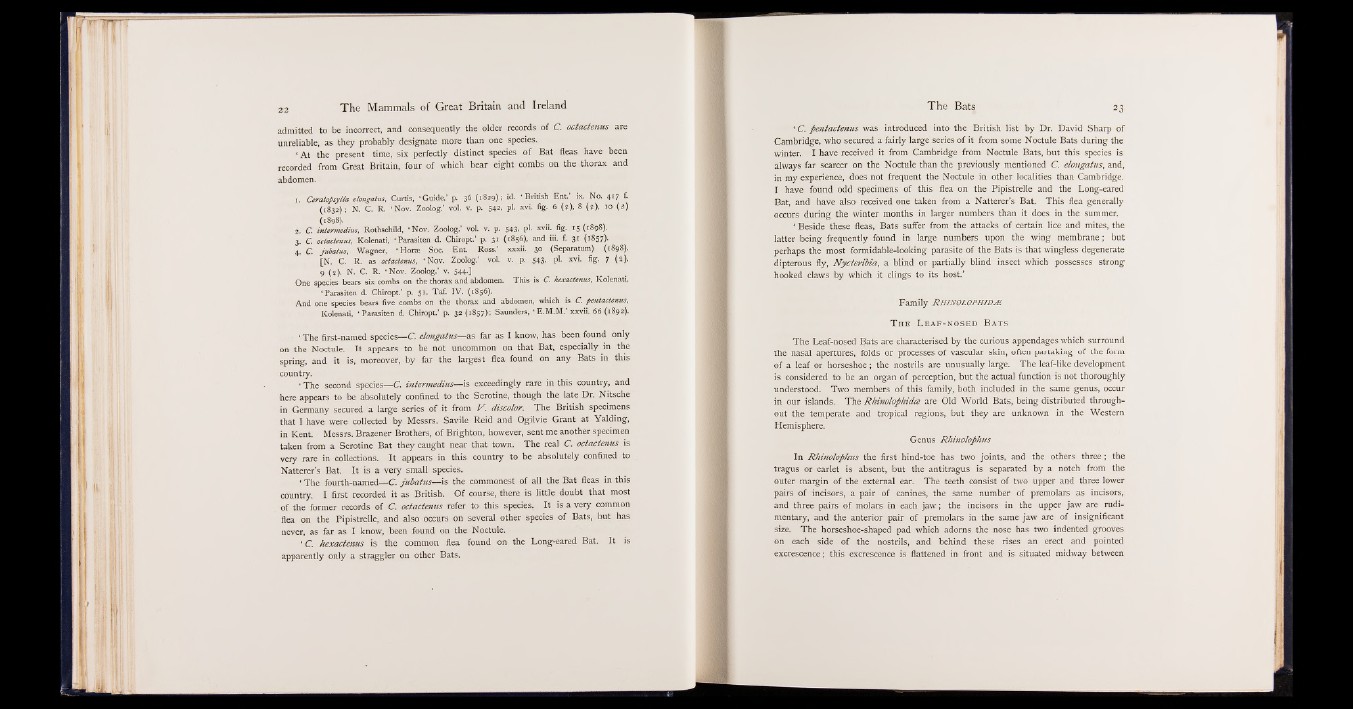
admitted to be incorrect, and consequently the older records of C. octactenus are
unreliable, as they probably designate more than one species..
‘ At the present time, six perfectly distinct species of Bat fleas, have been
recorded from Great Britain, four of which bear eight combs on the thorax and
abdomen.
1. Ceratopsylla elongatus, Curtis, ‘ Guide,’ p. 36 (1829); id. ‘ British Ent. ix. No. 417 f.
(1832); N. C. R. ‘ Nov. Zoolog.’ vol. v. p. 542, pi. xvi. fig. 6 (? ), 8 (? ), 10 (<?)
(1898).
2. C. intermedins, Rothschild, ‘ Nov. Zoolog.’ vol. v. p. 543, pi. xvii. fig. 15(1898).
3. C. octactenus, Kolenati, ‘ Parasiten d. Chiropt.’ p. 31 (1856), and in. f. 31 (1857).
4. C. jubatus, Wagner, ‘ Horae Soc. Ent. Ross.’ xxxii. 30 (Separatum) (1898).
[N. C. R. as octactenus, ‘ Nov. Zoolog.’ vol. v. p. 543> pi- xv** hg. 7 (?)»
9 (?). N. C. R. ‘ Nov. Zoolog.’ v. 544.]
One species bears six combs on the thorax and abdomen. This is C. hexactenus, Kolenati,
‘ Parasiten d. Chiropt.’ p. 5T> Taf. IV. (1856).
And one species bears five combs on the thorax and abdomen, which is C. pentactenus,
Kolenati, ‘ Parasiten d. Chiropt.’ p. 32 (1857); Saunders, ‘ E.M.M.’ xxvii. 66 (1892).
‘ The first-named species— C. elongatus— as far as I know, has been found only
on the Noctule. It appears to be not uncommon on that Bat, especially in the
spring, and it is, moreover, by far the largest flea found on any Bats in this
country.
‘ The second species— C. intermedius— is exceedingly rare in this country, and
here appears to be absolutely confined to the Serotine, though the late Dr. Nitsche
in Germany secured a large series of it from V . discolor. The British specimens
that I have were collected by Messrs. Savile Reid and Ogilvie Grant at Yalding,
in Kent. Messrs. Brazener Brothers, of Brighton, however, sent me another specimen
taken from a Serotine Bat they caught near that town. The real C. octactenus is
very rare in collections. It appears in this country to be absolutely confined to
Natterer’s Bat. It is a very small species.
‘ The fourth-named— C. jubatus— is the commonest of all the Bat fleas in this
country. I first recorded it as British. Of course, there is little doubt that most
of the former records of C. octactenus refer to this species. It is a very common
flea on the Pipistrelle, and also occurs on several other species of Bats, but has
never, as far as I know, been found on the Noctule.
‘ C. hexactenus is the common flea found on the Long-eared Bat. It is
apparently only a straggler on other Bats.
‘ C. pentactenus was introduced into the British list by Dr. David Sharp of
Cambridge, who secured a fairly large series of it from some Noctule Bats during the
winter. I have received it from Cambridge from Noctule Bats, but this species is
always far scarcer on the Noctule than the previously mentioned C. elongatus, and,
in my experience, does not frequent the Noctule in other localities than Cambridge.
I have found odd specimens of this flea on the Pipistrelle and the Long-eared
Bat, and have also received one taken from a Natterer’s Bat. This flea generally
occurs during the winter months in larger numbers than it does in the summer.
‘ Beside these fleas, Bats suffer from the attacks of certain lice and mites, the
latter being frequently found in large numbers upon the wing membrane; but
perhaps the most formidable-looking parasite of the Bats is that wingless degenerate
dipterous fly, Nyctenbia, a blind or partially blind insect which possesses strong
hooked claws by which it clings to its host.’
Family Rhinolophidjb
T h e L e a f - n o s e d B a t s
The Leaf-nosed Bats are characterised by the curious appendages which surround
the nasal apertures, folds or processes of vascular skin, often partaking of the form
of a leaf or horseshoe; the nostrils are unusually large. The leaf-like development
is considered to be an organ of perception, but the actual function is not thoroughly
understood. Two members of this family, both included in the same genus, occur
in our islands. The Rhinolopkidce are Old World Bats, being distributed throughout
the temperate and tropical regions, but they are unknown in the Western
Hemisphere.
Genus Rhinolophus
In Rhinolophus the first hind-toe has two joints, and the others three; the
tragus or earlet is absent, but the antitragus is separated by a notch from the
outer margin of the external ear. The teeth consist of two upper and three lower
pairs of incisors, a pair of canines, the same number of premolars as incisors,
and three pairs of molars in each jaw; the incisors in the upper jaw are rudimentary,
and the anterior pair of premolars in the same jaw are of insignificant
size. The horseshoe-shaped pad which adorns the nose has two indented grooves
on each side of the nostrils, and behind these rises an erect and pointed
excrescence; this excrescence is flattened in front and is situated midway between